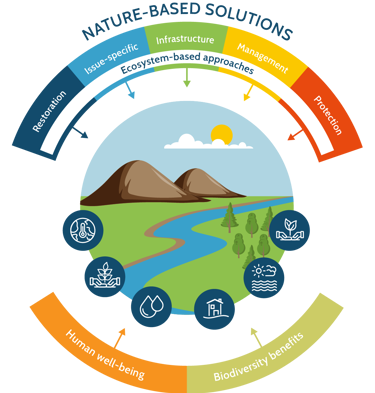
Nature-based solutions
We help local authorities, private companies and the third sector to deliver multiple outcomes and quantifiable benefits through effective and holistic engagement, design, delivery, integration and maintenance of nature-based solutions and blue-green infrastructure.
The climate and biodiversity crises are the defining challenges of the 21st Century. Our environmental-sustainability services work hand-in-hand with water and energy in addition to our wider business Directorates such as asset management and engineering and strategic advisory. Our embed to enhance approach is fundamental to every action and every deliverable to ensure we generate long-term, positive and resilient value for our clients, society and the environment.
We pride ourselves on our multidisciplinary strength and depth. This combined with this our embed to enhance approach ensure we can operate adaptively and effectively in the green-grey where others are unable to and in process forging strong client and stakeholder partnerships.
Our expertise covers a diverse range of interacting areas such as regulatory and investment planning, engineering and construction, flood risk management, nature-based solutions (NBS), blue-green infrastructure (BGI), biodiversity net gain (BNG) and bespoke natural asset management services.
We recognise how intertwined these areas are across the asset planning and engineering lifecycle and can provide end to end advice and integration services to deliver holistic outcomes and grow sustainable value for future generations.
What are nature-based solutions?
Nature-based Solutions are a wide-ranging set of actions used to protect, sustainably manage, and restore ecosystems in order to address environmental challenges for the benefit of people and nature. They can be adopted from small scale site enhancement (such as silt traps) through to river catchment or regional projects (such as floodplain restoration), depending on the scale of the problem. They can be adapted for use on heavily modified sites or within pristine natural environments.
Examples include:
- Riparian & flooded woodland (for flood & water quality management, soil retention & carbon storage)
- Peatland restoration (for carbon storage)
- Wetland creation & restoration (for natural flood management, water quality & biodiversity gain)
- Constructed wetlands & enhancements (for reedbeds, WQ enhancement, biodiversity enhancement)
- Hedgerows, meadows, grasslands, floodplains (for buffer strips, BNG)
- River restoration for BNG (marginal vegetation), LWD's & LWB's, slowing flow
- Lakes & ponds (for water storage, WQ enhancement, BNG)
What is blue-green infrastructure?
Blue-Green Infrastructure are a 'strategically planned network of natural and semi-natural areas with other environmental features designed and managed to deliver a wide range of ecosystem service'. It promotes the connection of existing ecological resources in order to maximise benefits to the environment and people. Examples range from widening of roadside corridors, enhancing ditch networks through to landscape scale recovery projects.
Examples include:
- Bioretention strips
- Swales
- Detention basins
- Retention ponds
- Permeable paving
- Rain gardens & rainwater harvesting
- Waterways & drainage channels
- Green walls
- Green roofs

Benefits
True end-to-end multidisciplinary expertise across strategic, technical, and operational capabilities to overcome siloed planning, delivery, maintenance, legacy and eventual replacement or deconstruction.
We identify, collect, analyse, monitor, and take action on the natural and built asset information and data which underpins opportunity and constrains decision-making and prioritisation - the right NBS & BGI in the right place.
Quantification and qualification of the outcomes and benefits associated with NBS and BGI to generate confidence in sustainable solutions.
We have experience and application across a broad client base from water companies and other asset owning organisations, government authorities, conservation charities, land management organisation and private landowners. This allows us to cross-pollinate and deliver outcomes for multiple organisations simultaneously.
Our specialist services around long-term delivery strategies, regulatory and business planning means we can link on the ground solutions to organisational-level vision and ambitions.
How we can help
Environment
- BNG assessments
- Natural capital valuations
- Ecosystem services assessments
- Ecological surveys & assessments
- Monitoring & evaluation
Strategic advisory
- Long term delivery strategies
- Adaptive planning pathways
- Cross-sector insight & knowledge transfer
- Economic & environmental regulator engagement
Asset management
- Built & natural asset investment case development
- Regulatory programme development & compliance (WINEP, DWMP, WRMP)
- Natural asset management
- Data needs & feeds mapping
Engineering
- Concept engineering
- Detailed design
- Commercial engineering
- Solution development
Commercial
- Nature-based cost models
- Supply chain insights
- Procurement & contractual models
Case study
Aqua Consultants as part of the strategic planning partnership provided the outline design for this scheme, which required the development of solution options and scoping for a phosphorus permit of 2mg/l and BOD of 10mg /l on a 350 PE rural works. There was also a frequent spilling CSO on site and no storage for storm water.
Alongside input from process, civil and MEICA engineers, the scheme required ground investigation, river modelling, hydraulic modelling, a topographical survey, and ecological surveys. Scopes were developed and costed for various solution options including integrated constructed wetlands (ICW).
An optioneering and scoping proposal for a P removal and BOD scheme including an opportunity to remove the CSO. The proposal also specified gravity and pumped feed ICW options sizing, earthworks, planting, hydraulics, and costing.
The recommended option of an ICW provided the lowest CAPEX, OPEX, carbon, and ensured biodiversity net gain. It also provided the opportunity to remove a high spilling CSO at a low cost.
Key contacts

Tom Rathmell

Michael Clark
You might also be interested in...
Here to solve your biggest challenges and grow sustainable value
Our expert consultants are available to broaden your thinking, lead transformation, and help you achieve successful outcomes.
Contact our experts




